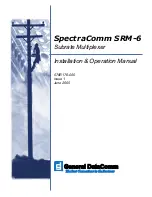
WARNING:
This
function
could
be
affected
by
different
external
interference
sources,
and
then
the
alarm
is
activated
by
wrong
signal.
The
measurement
result
is
for
reference
only.
Turn
the
rotary
function
switch
to
“NCV”
position.
When
the
testing
circuit
is
placed
above
the
meter,
the
meter
displays
the
strength
of
signal,
and
the
buzzer
alarms
with
“beep
beep”.
NOTE:
1)
Even
if
there
is
no
voltage
indication,
there
may
be
voltage
on
the
circuit.
Do
not
rely
on
NCV
detector
as
the
only
way
to
detect
voltage.
2)
Voltage
detecting
may
be
affected
by
power
socket
design,
type
of
insulation
and
its
thickness
and
other
factors.
3)
Interference
sources
in
the
external
environment,
such
as
flashing
light,
motor,
would
cause
wrong
signal
to
activate
alarm
function.
4.10
DIODE
AND
CONTINUITY
TEST
4.10.1
Insert
the
black
test
lead
into
“COM”
terminal
and
the
red
one
into
“V
Ω
mA”
terminal
(the
polarity
of
red
lead
is
“+”);
4.10.2
Turn
the
rotary
switch
to
“
Ω
”
range,
and
press
“SELECT/
”
key
to
choose
“
”
mode;
4.10.3
Forward
measurement:
connect
red
test
lead
to
the
positive
polarity
and
the
black
test
lead
to
the
negative
polarity
of
the
diode.
LCD
will
display
the
approx.
value
of
forward
voltage
drop;
4.
10.4
Backward
measurement:
connect
red
test
lead
to
the
negative
polarity
and
the
black
test
lead
to
positive
polarity
of
the
diode.
LCD
will
display
“OL”;
4.10.5
The
complete
diode
test
includes
forward
and
backward
measurement,
if
the
result
doesn’t
meet
the
descriptions
above;
it
means
the
diode
is
broken;
4.10.6
Press
“SELECT/
”
key
to
select
the
continyity
measurement
mode;
4.10.7
Connect
test
leads
to
two
points
of
tested
circuit,
if
the
resistance
is
less
than
50
Ω
,
the
built
‐
in
buzzer
sounds.
NOTE:
1)
DO
NOT
input
voltage
at
“
Ω
”
range.
2)
When
test
circuits,
make
sure
the
power
is
off
and
all
capacitors
are
discharged.
Any
negative
potential
or
AC
signal
will
activate
the
buzzer.
4.11
TEMPERATURE
MEASUREMENT
4.11.1
Turn
the
rotary
switch
to
“
℃
/
℉
”
range.
Press
“SELECT/
”
key
to
select
℃
or
℉
mode.
4.11.2
Insert
the
cold
end
(free
end)
of
thermocouple
in
“V
Ω
mA(+)”
and
“COM(
‐
)”
terminal,
and
put
the
working
end
(temperature
measuring
end)
of
thermocouple
on
the
surface
or
inside
the
tested
object.
Then
LCD
will
display
the
temperature
of
tested
object,
and
the
reading
is
in
℃
/
℉
(when
the
polarity
is
contrary.
The
reading
will
decrease
when
the
temperature
of
the
tested
object
increase).
NOTE:
1)
When
the
input
terminal
is
open
circuit,
it
will
display
the
environment
temperature.
2)
To
ensure
measure
accuracy,
do
not
replace
the
temperature
probe
unless
it
is
necessary.
3)
Do
not
input
voltage
at
temperature
range.
5.
MAINTENANCE
This
meter
is
a
precise
instrument.
Any
modification
to
the
circuit
is
not
allowed.
NOTE:
1)
Don’t
input
the
voltage
value
higher
than
600V
DC
or
ACrms.
2)
Don’t
input
voltage
at
current,
resistance,
diode
or
continuity
range.
3)
Don’t
make
any
measurements
when
the
battery
is
not
properly
installed
or
the
back
cover
isn’t
fixed.
4)
Before
replacing
battery
or
fuse,
please
remove
the
test
leads
from
the
measuring
point
and
turn
off
the
power.
5)
Keep
the
meter
away
from
water,
dust
and
shock.
6)
Don't
expose
the
meter
under
high
temperature,
high
humidity,
combustible,
explosive
and
strong
magnetic
place.


























